Freddi,
Thanks for the very nice plan of the Gauss 5181 - how did you come about getting such a perfect scan? There appears to be two rectangular openings or ports on the side of the box is that correct? Or am I reading the drawing incorrectly? That would have effect of relieving a lot of pressure that would normally go through K aperture.
Thanks for the very nice plan of the Gauss 5181 - how did you come about getting such a perfect scan? There appears to be two rectangular openings or ports on the side of the box is that correct? Or am I reading the drawing incorrectly? That would have effect of relieving a lot of pressure that would normally go through K aperture.
Ok,
I think those two cutouts on the side are for chrome hinged roadshow box handle pockets - seeing how they have protective roadshow corners on the box. What gave it away was that it is mounted at the center of gravity where the magnet is so you can pick it up straight. If you think about it, a box this big would be tough to pick up by one person without some sort of handles. Going with a Gauss K18 would be just almost as good as the K19 I sim'd for the off spec Beta 12CX. Now I need to wait until I have a proper workshop with a table saw. I don't think this can fare well in Corning XPS foam.
I think those two cutouts on the side are for chrome hinged roadshow box handle pockets - seeing how they have protective roadshow corners on the box. What gave it away was that it is mounted at the center of gravity where the magnet is so you can pick it up straight. If you think about it, a box this big would be tough to pick up by one person without some sort of handles. Going with a Gauss K18 would be just almost as good as the K19 I sim'd for the off spec Beta 12CX. Now I need to wait until I have a proper workshop with a table saw. I don't think this can fare well in Corning XPS foam.
I don't think this can fare well in Corning XPS foam.
Probably not. 😉
Handles wouldn't be necessary for home use. Stick some magic glides on the bottom and call it a day. For MI/band use, it would be sadistic to not put wheels on it.
Hi, I need some advice what to build as I just recently acquired a pair of Lafayette Triaxiom SK 215 WX full range 15" speaker, was wondering whether to built a K15 cab or an Onken. I have a fairly large room 31ft x 16 ft x 9 ft and using tube amp, 300B DIY.
Hi, I need some advice what to build as I just recently acquired a pair of Lafayette Triaxiom SK 215 WX full range 15" speaker, was wondering whether to built a K15 cab or an Onken. I have a fairly large room 31ft x 16 ft x 9 ft and using tube amp, 300B DIY.
Get me the T/S params and I will run a sim for you in a K15.
Hey X, have you looked at the Metro T15 Karlson type sub?
good measurements and discussion (and hyperbole) in their pdf here:
http://www.metroaudiosystems.gr/pages/manuals/E_Array_Manual_en.pdf
I'm thinking about building a couple (4) and open to whatever motor works best for PA duties... The size is good and the visual aesthetic hints less at reproductive organs than taller aspect K's. Any chance you could plug some numbers and see if it's worth the wood? The folding and vent scheme is a bit different than k15 yeah? - Dimensions of the T15 construction are available on this youtube video for first couple hundred frames... (480p is helpful)..
T15 Bass Bin based on Metro Audio's E-Array System - YouTube
For PA use the 43hz LF corner is about right (if it was measured in 1/2 space!?), Another thing i'm wondering is how high we could get it to play above the recommended 190hz before it turns into a phase cave? Metro's smoothed measurements show it dipping in a friendly V shaped notch between 190hz and 270hz (depending on how we measure that's 6-10dB down). Thankfully, this frequency region is often identified with "mud" by mixing and mastering folks who regularly cut it to provide contrast in a mix....further, in this case the PA system is for live musicians, so having a notch at 220-240hz will in many cases be beneficial assuming the 260->340hz is useable as crossover range.
Comparing to Danley's TH115 by specs,,, and given my desire for portability; the Metro/Karlson T15 makes a lot of sense being much smaller at sig. less weight (90lb vs 152) with more HF extension (in theory). 100dB @ 1watt/1meter average sensitivity is plenty efficient given that we try to keep our event attendance to less than 100 persons. And we can get 2 speakers for just 30lb more than the weight of one TH115 giving us the option of setting up a Quad system (and Karlson's excellent dispersion seems ideally matched for a quad space even though it might be wasted given we're not reaching up to 700Hz (ears typical upper limit for stereo information retrieval).
?
good measurements and discussion (and hyperbole) in their pdf here:
http://www.metroaudiosystems.gr/pages/manuals/E_Array_Manual_en.pdf
I'm thinking about building a couple (4) and open to whatever motor works best for PA duties... The size is good and the visual aesthetic hints less at reproductive organs than taller aspect K's. Any chance you could plug some numbers and see if it's worth the wood? The folding and vent scheme is a bit different than k15 yeah? - Dimensions of the T15 construction are available on this youtube video for first couple hundred frames... (480p is helpful)..
T15 Bass Bin based on Metro Audio's E-Array System - YouTube
For PA use the 43hz LF corner is about right (if it was measured in 1/2 space!?), Another thing i'm wondering is how high we could get it to play above the recommended 190hz before it turns into a phase cave? Metro's smoothed measurements show it dipping in a friendly V shaped notch between 190hz and 270hz (depending on how we measure that's 6-10dB down). Thankfully, this frequency region is often identified with "mud" by mixing and mastering folks who regularly cut it to provide contrast in a mix....further, in this case the PA system is for live musicians, so having a notch at 220-240hz will in many cases be beneficial assuming the 260->340hz is useable as crossover range.
Comparing to Danley's TH115 by specs,,, and given my desire for portability; the Metro/Karlson T15 makes a lot of sense being much smaller at sig. less weight (90lb vs 152) with more HF extension (in theory). 100dB @ 1watt/1meter average sensitivity is plenty efficient given that we try to keep our event attendance to less than 100 persons. And we can get 2 speakers for just 30lb more than the weight of one TH115 giving us the option of setting up a Quad system (and Karlson's excellent dispersion seems ideally matched for a quad space even though it might be wasted given we're not reaching up to 700Hz (ears typical upper limit for stereo information retrieval).
?
Anthony Bisset,
Thanks for the tip on the Metro T15 - never knew a Karlson existed as a commercial line-array product for touring bands. I just looked over the description and it does indeed sound interesting. I will see what I can do to build a model when I have some time - it is quite different from the K15 so this will take some work - it's actually a lot of work as the K15 script is about 300 lines of code. Do you have anything to trade for new Akabak model of the T15? 🙂
Metro is apparently using a B&C 15 in driver. Do you have another one in mind? I know those drivers are very good (and expensive) - not surprising that they can achieve 100 dB sensitivity. The advantage it has over the K15 is the bass extension down to the mid 40 Hz's - which is pretty low. Regular K15's have some trouble reaching below 50 Hz in the main power band.
Having said all this, I don't know if you know that a K15 can achieve 100 dB with an Eminence coaxial Beta 15CX driver? I have not run a sim for a Delta 15 but that may even be better. Are you interested in this route if you can achieve 95 dB at 45 Hz?
Thanks for the tip on the Metro T15 - never knew a Karlson existed as a commercial line-array product for touring bands. I just looked over the description and it does indeed sound interesting. I will see what I can do to build a model when I have some time - it is quite different from the K15 so this will take some work - it's actually a lot of work as the K15 script is about 300 lines of code. Do you have anything to trade for new Akabak model of the T15? 🙂
Metro is apparently using a B&C 15 in driver. Do you have another one in mind? I know those drivers are very good (and expensive) - not surprising that they can achieve 100 dB sensitivity. The advantage it has over the K15 is the bass extension down to the mid 40 Hz's - which is pretty low. Regular K15's have some trouble reaching below 50 Hz in the main power band.
Having said all this, I don't know if you know that a K15 can achieve 100 dB with an Eminence coaxial Beta 15CX driver? I have not run a sim for a Delta 15 but that may even be better. Are you interested in this route if you can achieve 95 dB at 45 Hz?
I will see what I can do to build a model when I have some time - it is quite different from the K15 so this will take some work - it's actually a lot of work as the K15 script is about 300 lines of code. Do you have anything to trade for new Akabak model of the T15? 🙂
Wow thanks! I'm a fan of the barter economy so I better pm u with esoteric and likely useless offers... 😀
Having said all this, I don't know if you know that a K15 can achieve 100 dB with an Eminence coaxial Beta 15CX driver? I have not run a sim for a Delta 15 but that may even be better. Are you interested in this route if you can achieve 95 dB at 45 Hz?
Several things about the K15 that push me towards the T15...
- The K15 is ~33x22x18" vs. T15 at ~22x20x23" (we save ~8 linear inches, which adds up and becomes critical given that we need to fly tops.
- being down ~10db at 40hz is more than I like given quite a few of our performers make extensive use of analog drum machines and modular synths.
- the K15 visual is hard to take seriously and I'm working with engineers who run sound for large tours... The more squat T15 looks less like a super TW$T 😀 (actually I like the super TW$T, it's just the K12 and K15 that conjure weird images of plywood sex, must be the proportions.)
- If we went the coax route then we'd need to elevate them a la Sound Projectors which voids our half space LF bump and brings back the need for 2 subs.
- A quarter-point is the T15 style cab looks like it will be a little better at keeping dust out of the back chamber.
FWIW, we have a fairly nice/modern Martin setup (300lb cabinets) and some super funky hard hitting DIY speakers that make an appearance some years, but both these systems have the usual issues: size, weight, efficiency, directivity, and to my ears they are both coming up short sonically. I should make a thread sometime about these weird trapezoidal metronome type dual 15" towers that facilitate a terrifying upper bass punch, but stand nearly 4ft tall and don't make right angles when placed against each other and *seem to have* serious issues providing a flat FR.
I've seen one mention of the Kilomax's being bad in K15 (but no details given). We have 4 Eminence Kilomax 15's in the trapezoids of doom that could be requisitioned for the T15's (if they were able to perform well). But this isn't a mission of convenience. My priority is that the 30 or so performers that show up have something of an audiophile experience and enjoy playing on the system, so whatever speaker can deliver will be my target (of course, I'd like to spend less than $600ea and would be happy from a purely economic standpoint in the $300 zone).
Last edited:
Anthony Bisset,
I never looked at a Kilomax before, looks like a hard hitting driver, I will run sim in a K15 and see if there is any truth to why it doesn't work there. The resemblance to anatomical parts never occurred to me 🙂
It is still there in the T15 but I guess a square box is less evocative of certain parts. Esoteric useless things do interest me. 😀
Regards,
X
I never looked at a Kilomax before, looks like a hard hitting driver, I will run sim in a K15 and see if there is any truth to why it doesn't work there. The resemblance to anatomical parts never occurred to me 🙂
It is still there in the T15 but I guess a square box is less evocative of certain parts. Esoteric useless things do interest me. 😀
Regards,
X
T15 may have had a PHL woofer - but B&C have woofers to cover that T-S
PHL Audio 15 inch Woofer No SSL15 11 or 5200P | eBay
when the late Gregg Baker had a T15 built, he ended up with a small pipe duct instead of the rectangular duct "hinted" at in the drawing - it would be great to find a picture of a T15 with its access door open.


PHL Audio 15 inch Woofer No SSL15 11 or 5200P | eBay
when the late Gregg Baker had a T15 built, he ended up with a small pipe duct instead of the rectangular duct "hinted" at in the drawing - it would be great to find a picture of a T15 with its access door open.


An externally hosted image should be here but it was not working when we last tested it.
Last edited:
T15 Plan
Freddi,
Great to hear you are back!
I don't know how accurate this plan is, but I got it from the first few seconds of the YouTube video link that Anthony Bisset provided above. I assume these were actual measurements by the person who posted the video. Anyhow, here is a screenshot of the plan - it's actually high enough resolution to use.
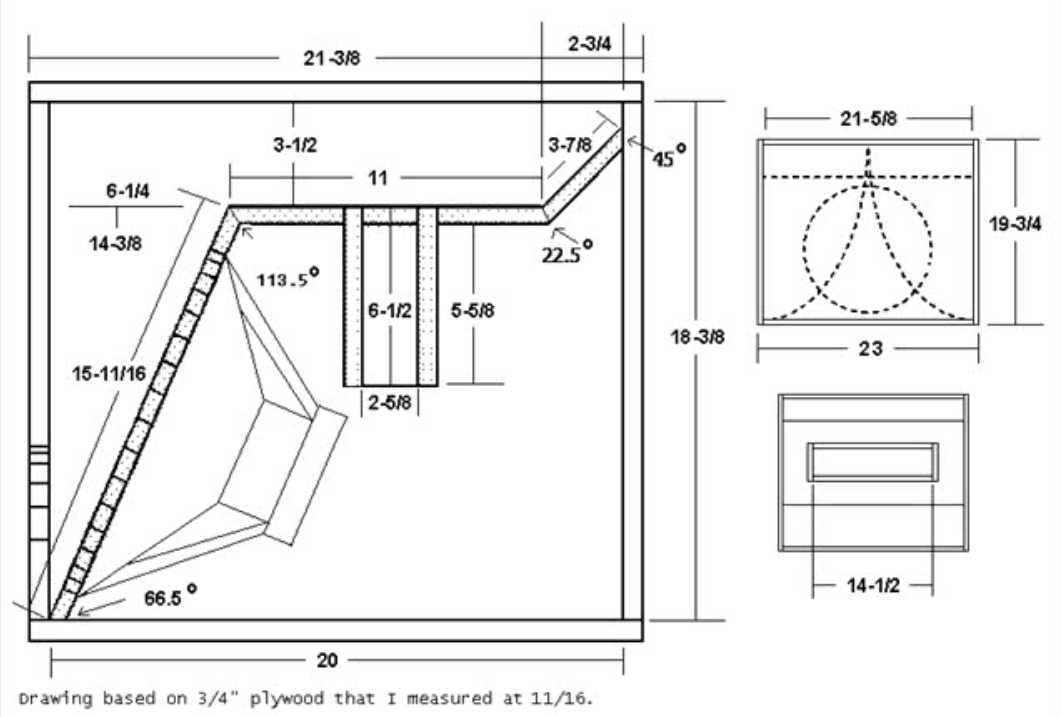
The Metro T15 literature says that they use B&C drivers and they achieve a +3dB boost from the T15 enclosure, so that would make the drivers a 97 dB efficiency model. Not sure which particular one that is. I think Eminence has 97 or 98 dB drivers that can be substituted - but we won't know which is best until I build the model and run the sim.
Here is the plan:
Freddi,
Great to hear you are back!
it would be great to find a picture of a T15 with its access door open.
I don't know how accurate this plan is, but I got it from the first few seconds of the YouTube video link that Anthony Bisset provided above. I assume these were actual measurements by the person who posted the video. Anyhow, here is a screenshot of the plan - it's actually high enough resolution to use.

The Metro T15 literature says that they use B&C drivers and they achieve a +3dB boost from the T15 enclosure, so that would make the drivers a 97 dB efficiency model. Not sure which particular one that is. I think Eminence has 97 or 98 dB drivers that can be substituted - but we won't know which is best until I build the model and run the sim.
Here is the plan:
Attachments
where do you think Gregg's interpretation tunes with the rectangular duct vent shown in his plan which you snapped from YouTube? - he had to re-tune for the Eminence - think had had difficulty getting good LF measurements in-room
does Metro's T15 scheme affect the front chamber's potential cavity peak placement and amplitude? - overall bulk wise, its not real far off from Karlson's X15
does making a K taller as Carl builds, tend to tune the front lower so peaking may be avoided? cavity shape must have some influence.
if I could only get some help to cut wood then I might try a rough T15 - already have two slightly different parameter B&C
does Metro's T15 scheme affect the front chamber's potential cavity peak placement and amplitude? - overall bulk wise, its not real far off from Karlson's X15
does making a K taller as Carl builds, tend to tune the front lower so peaking may be avoided? cavity shape must have some influence.
if I could only get some help to cut wood then I might try a rough T15 - already have two slightly different parameter B&C
Last edited:
Freddi,
I got that video from someone called binwhiffer on YouTube. That isn't the same as the Greg you are referring to is it? I don't know how much the shape of the front cavity affects the sound and performance - I would say with a 20 in T15 the shape is not as important as the volume - although the T15 does a neat trick by folding the front cavity by 90 def essentially making it an effective 40 in long cavity and that length certainly has an effect. This could explain why the T15 can reach down to mid 40 Hz. So, yes, making a K15 taller and keeping volume fixed will probably help it reach lower frequencies. However I think the tuning freq is dominated by the dual chamber bandpass box parts (front volume and rear volume and vent connecting them).
I got that video from someone called binwhiffer on YouTube. That isn't the same as the Greg you are referring to is it? I don't know how much the shape of the front cavity affects the sound and performance - I would say with a 20 in T15 the shape is not as important as the volume - although the T15 does a neat trick by folding the front cavity by 90 def essentially making it an effective 40 in long cavity and that length certainly has an effect. This could explain why the T15 can reach down to mid 40 Hz. So, yes, making a K15 taller and keeping volume fixed will probably help it reach lower frequencies. However I think the tuning freq is dominated by the dual chamber bandpass box parts (front volume and rear volume and vent connecting them).
I don't know which version of Take5 was used in the video, but I grabbed the audio, found the most bassy passage and looped it up with peakhold meters running:

Without the original recording to compare this frequency response against I can't conclude much (variables include wondering if this version was mastered for vinyl which is necessarily bass-shy to prevent skipping), but I can see jumpy/dynamic meters below 30Hz and they are only -15dB down from the materials peaks at ~70Hz. I have no idea how room gain factored into the recording, perhaps it was made in a concrete basement?
FWIW, the Nady CM100 mic used to record the T15 for the youtube video is highly linear from 15hz-20khz...
Freddi, any idea if GregB's struggle to get LF in room related to the room? Do you know if he ever measured outdoors?
If someone can definitely identify the video's version of Take5 I'll see if I can snag the single on itunes.

Without the original recording to compare this frequency response against I can't conclude much (variables include wondering if this version was mastered for vinyl which is necessarily bass-shy to prevent skipping), but I can see jumpy/dynamic meters below 30Hz and they are only -15dB down from the materials peaks at ~70Hz. I have no idea how room gain factored into the recording, perhaps it was made in a concrete basement?
FWIW, the Nady CM100 mic used to record the T15 for the youtube video is highly linear from 15hz-20khz...
Freddi, any idea if GregB's struggle to get LF in room related to the room? Do you know if he ever measured outdoors?
If someone can definitely identify the video's version of Take5 I'll see if I can snag the single on itunes.
Last edited:
Simulation of Klam 10
Freddi,
Well I finally got around to modeling the Klam 10 based on the drawings you provided: 22.25 in deep x 11 in high x 15.25 in wide with a 7.125 in x 11 in x 15.25 in rear chamber. I used a Beta 10CX for the driver as you requested and placed the speaker up high like shown in the pictures. I assumed it is stand mounted at 6 ft high (driver centerline) and the mic "listening position" is equivalent to a seated person with mic at 48 in high. The back wall is far away at 60 in.
I did two cases: a sealed rear chamber filled with stuffing, and a vented rear chamber tuned for 50 Hz with a rectangular (15.25 in wide x 0.86 in tall) slot vent coming out the front.
Plots are as follows:
- Freq response for sealed back (red is output from one of the 9 vents that comprise the aperture)
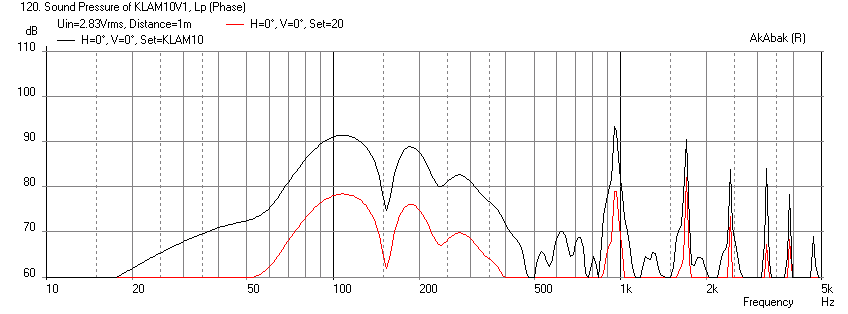
- Impedance for sealed back
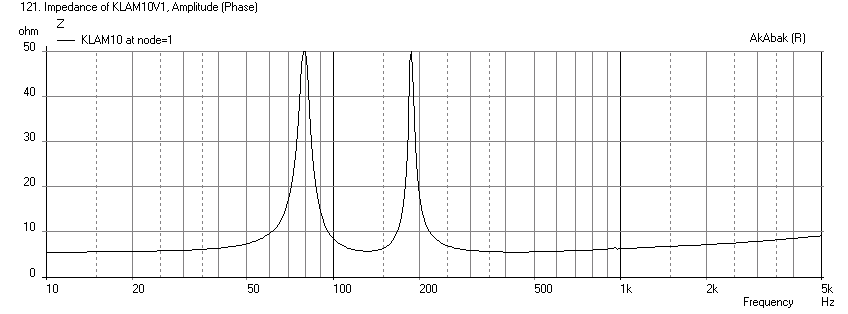
- Cone displacement for sealed back
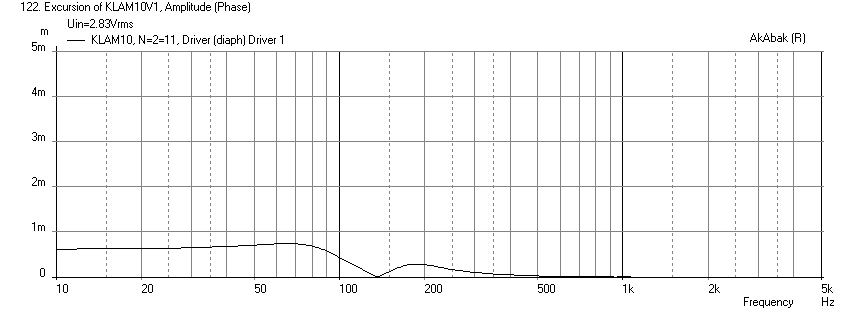
- Freq response for vented chamber (green is rear chamber vent output)
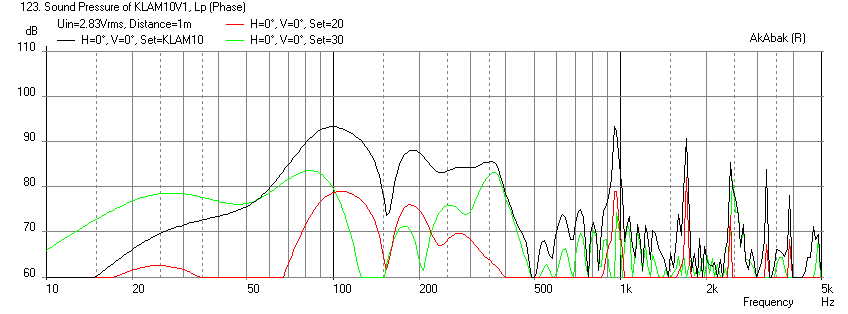
- Impedance for vented chamber
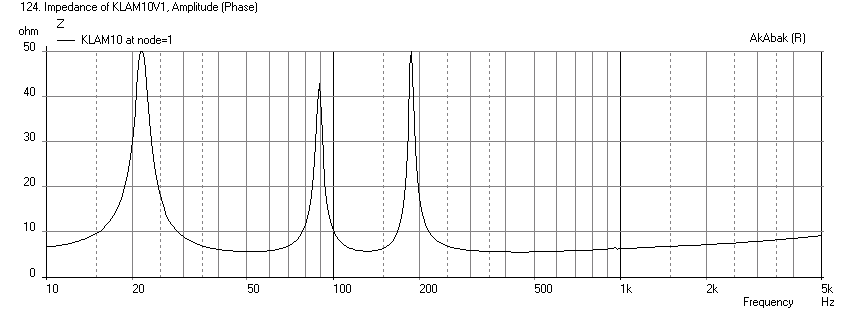
- Cone displacement for vented chamber
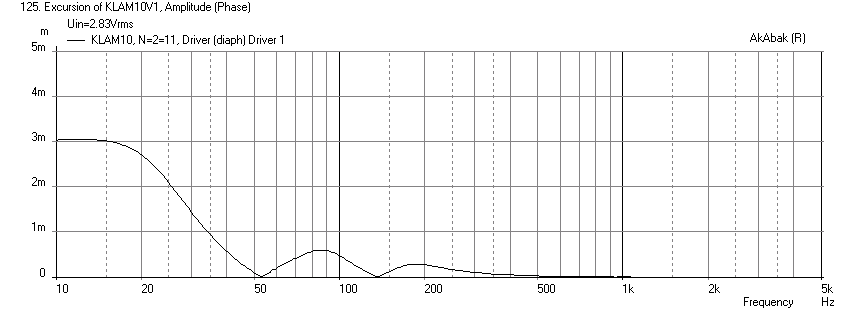
I am not sure if I modeled this correctly but I used the same approach for modeling the Karlson aperture as before with 9 segments of a waveguide that has ducts of varying cross sectional area dictated by the Karlson aperture function. The simulations indicate that the Klam 10 is not a particularly efficient speaker. It is also has a much smaller bandpass than the K15 - acting more like bass cabinet with an upper cutoff frequency of about 400 Hz. So it will definitely need a tweeter and need one that can go pretty low. Although, the model may not be correctly accounting for how much high freq radiation leaks through the Karlson aperture - this is probably the case as in my Karlsonator sim, it says there is not much about 3 kHz, but with the mini Karlsonator I clearly get up to 16 kHz.
One good thing about the sealed version is that it can handle a lot of power as there is hardly any cone movement (as expected for a sealed box). The vented version provides a slightly wider bandpass (in the upper portion) but not much better in the low end due to the limited volume of the back chamber (should be twice as big).
Anyhow, let me know if your listening impressions are consistent with the model or if you have some measurements even better. First thing I would notice is not much bass below 80 or 90 Hz.
X- how tough is it for you to model a Klam?
Freddi,
Well I finally got around to modeling the Klam 10 based on the drawings you provided: 22.25 in deep x 11 in high x 15.25 in wide with a 7.125 in x 11 in x 15.25 in rear chamber. I used a Beta 10CX for the driver as you requested and placed the speaker up high like shown in the pictures. I assumed it is stand mounted at 6 ft high (driver centerline) and the mic "listening position" is equivalent to a seated person with mic at 48 in high. The back wall is far away at 60 in.
I did two cases: a sealed rear chamber filled with stuffing, and a vented rear chamber tuned for 50 Hz with a rectangular (15.25 in wide x 0.86 in tall) slot vent coming out the front.
Plots are as follows:
- Freq response for sealed back (red is output from one of the 9 vents that comprise the aperture)

- Impedance for sealed back

- Cone displacement for sealed back

- Freq response for vented chamber (green is rear chamber vent output)

- Impedance for vented chamber

- Cone displacement for vented chamber

I am not sure if I modeled this correctly but I used the same approach for modeling the Karlson aperture as before with 9 segments of a waveguide that has ducts of varying cross sectional area dictated by the Karlson aperture function. The simulations indicate that the Klam 10 is not a particularly efficient speaker. It is also has a much smaller bandpass than the K15 - acting more like bass cabinet with an upper cutoff frequency of about 400 Hz. So it will definitely need a tweeter and need one that can go pretty low. Although, the model may not be correctly accounting for how much high freq radiation leaks through the Karlson aperture - this is probably the case as in my Karlsonator sim, it says there is not much about 3 kHz, but with the mini Karlsonator I clearly get up to 16 kHz.
One good thing about the sealed version is that it can handle a lot of power as there is hardly any cone movement (as expected for a sealed box). The vented version provides a slightly wider bandpass (in the upper portion) but not much better in the low end due to the limited volume of the back chamber (should be twice as big).
Anyhow, let me know if your listening impressions are consistent with the model or if you have some measurements even better. First thing I would notice is not much bass below 80 or 90 Hz.
Attachments
Last edited:
I don't know which version of Take5 was used in the video, but I grabbed the audio, found the most bassy passage and looped it up with peakhold meters running:

Without the original recording to compare this frequency response against I can't conclude much (variables include wondering if this version was mastered for vinyl which is necessarily bass-shy to prevent skipping), but I can see jumpy/dynamic meters below 30Hz and they are only -15dB down from the materials peaks at ~70Hz. I have no idea how room gain factored into the recording, perhaps it was made in a concrete basement?
FWIW, the Nady CM100 mic used to record the T15 for the youtube video is highly linear from 15hz-20khz...
Freddi, any idea if GregB's struggle to get LF in room related to the room? Do you know if he ever measured outdoors?
If someone can definitely identify the video's version of Take5 I'll see if I can snag the single on itunes.
When I listened to it I also noticed that there was quite a bass-heavy coloration to the song - I know this song well and think it may have something to do with room gain. But if he were listening to the song from a T15 without a tweeter - it wouldn't surprise me that it is bass-centric as the Karlson type enclosure with a 15 in typically doesn't have much output above 1.5 kHz.
Okay I did a bit more investigating... I won't bother with graphs until I have something conclusive, but, It's looking like the T15 youtube demo was playing back a remastered version of Take 5 *or* the T15 (in that room, on that amp, with whatever venting scheme) has some serious bass enhancement going on below 50hz. Something like a +15dB shelf. The original release of Take 5 is bass light below 50hz as I would have expected for vinyl.
Take 5 by the Dave Brubeck Quartet was recorded in 1959 and remains as one of my favorite jazz recordings. The sound quality of that recording was excellent. The Quartet had the usual piano, alto sax, stand up bass, and drums. Not too much below 40 or 50 Hz here. This recording posted on YouTube is quite good if anyone wants to hear the original version. Listening to this on a 1955 Karlson K15 with a coax would be very period appropriate and probably sort of how it sounded to folks listening back then.
http://www.youtube.com/watch?v=nzpnWuk3RjU&
http://www.youtube.com/watch?v=nzpnWuk3RjU&
hey X - thank you very much for working out the klam -
here's some old notes
the first graphs used averaged pink noise as I could not get good enough signal-to-noise for swept-sine. - - part of that was my fault for testing at ~1 watt. -- rasing drive to ~10 watts in later plots along this list got swept-sine recognized.
Klam 10 sat on top of a plastic barrel and microphone was ~9 feet away. Klam 10 was built nicely by John Lapaire ~ to Carl's dimensions (slot and nose may be a bit tighter) - the aperture came out too "tight" by 1.5" at the final width
resonance is around 100Hz and "Qtk" ~0.62
the few dispersion plots were taken at only one elevation so its not known how much that parameter changes with elevation and varying frequency.
if I could just re-cut the aperture to a radial arc which opens the full width, I know the sound with Beta10cx and compression driver would be pretty impressive
Klam10/B102 on/off and 100Hz sine spectrum ~1 watt input - maximum resolution of 1/24 octave.
Klam10/B102 same ~1W responses but 100Hz sine bumped up to ~9vrms to see change in distortion
Klam10/B102 same ~1W responses but 100Hz sine bumped up to ~22vrms/ 60 watts
Klam10/B102 laying on ground with slot "up" (of koarse), mic on ground ~9 feet away
Klam10/B102 laying on ground with slot up and mic 9 feet back and 7 feet elevation
Klam10/B102 vs Klam8/Sammi 8 "on-axis" back on the barrel and 1/24 octave resolution
Klam10/B102 vs Klam8/Sammi 8 same data as above but smoothed to 1/6 octave
klams seem to have very good vertical response so if one sat under one, timbre preservation would be good.
Karlson-Oliver Phase III klam loaded with the early and stronger B102 - mic down under the slot in perspective
klam8 at first was a copy built from Alan Weiss's suggestions at the old Ulfman Karlson forum _ later I found the real thing
- here's the copy - Alan used an ~40 degree angle in this and his tweeter lens
here's some old notes
the first graphs used averaged pink noise as I could not get good enough signal-to-noise for swept-sine. - - part of that was my fault for testing at ~1 watt. -- rasing drive to ~10 watts in later plots along this list got swept-sine recognized.
Klam 10 sat on top of a plastic barrel and microphone was ~9 feet away. Klam 10 was built nicely by John Lapaire ~ to Carl's dimensions (slot and nose may be a bit tighter) - the aperture came out too "tight" by 1.5" at the final width
resonance is around 100Hz and "Qtk" ~0.62
the few dispersion plots were taken at only one elevation so its not known how much that parameter changes with elevation and varying frequency.
if I could just re-cut the aperture to a radial arc which opens the full width, I know the sound with Beta10cx and compression driver would be pretty impressive
Klam10/B102 on/off and 100Hz sine spectrum ~1 watt input - maximum resolution of 1/24 octave.
An externally hosted image should be here but it was not working when we last tested it.
Klam10/B102 same ~1W responses but 100Hz sine bumped up to ~9vrms to see change in distortion
An externally hosted image should be here but it was not working when we last tested it.
Klam10/B102 same ~1W responses but 100Hz sine bumped up to ~22vrms/ 60 watts
An externally hosted image should be here but it was not working when we last tested it.
Klam10/B102 laying on ground with slot "up" (of koarse), mic on ground ~9 feet away
An externally hosted image should be here but it was not working when we last tested it.
Klam10/B102 laying on ground with slot up and mic 9 feet back and 7 feet elevation
An externally hosted image should be here but it was not working when we last tested it.
Klam10/B102 vs Klam8/Sammi 8 "on-axis" back on the barrel and 1/24 octave resolution
An externally hosted image should be here but it was not working when we last tested it.
Klam10/B102 vs Klam8/Sammi 8 same data as above but smoothed to 1/6 octave
An externally hosted image should be here but it was not working when we last tested it.
klams seem to have very good vertical response so if one sat under one, timbre preservation would be good.
Karlson-Oliver Phase III klam loaded with the early and stronger B102 - mic down under the slot in perspective
An externally hosted image should be here but it was not working when we last tested it.
klam8 at first was a copy built from Alan Weiss's suggestions at the old Ulfman Karlson forum _ later I found the real thing
- here's the copy - Alan used an ~40 degree angle in this and his tweeter lens
An externally hosted image should be here but it was not working when we last tested it.
Last edited:
- Home
- Loudspeakers
- Full Range
- A Speaker that Kicks Butt in Large Spaces






